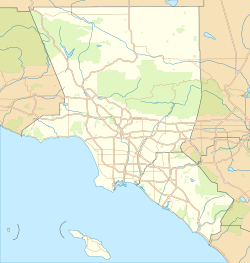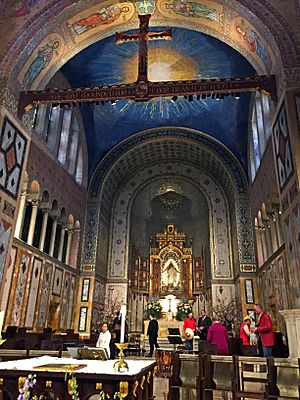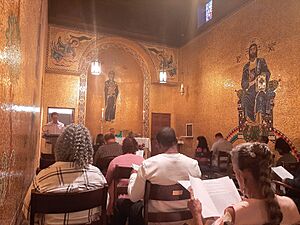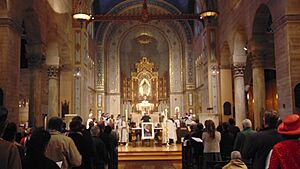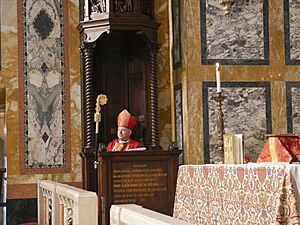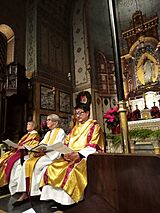St. John's Cathedral (Los Angeles) facts for kids
Quick facts for kids Saint John's Cathedral |
|
|---|---|
| Saint John's Episcopal Cathedral | |
| Catedral Episcopal San Juan
聖約翰大教堂 세인트 존 성공회 대성당 |
|
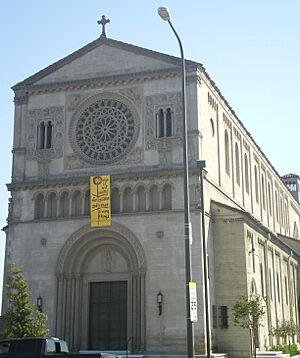 |
|
| Location | University Park, Los Angeles |
| Language(s) | Primarily English, readings might be performed in Spanish, Korean, Japanese, and Chinese. |
| Denomination | Episcopal Church |
| Tradition | Central churchmanship |
| Churchmanship | Liberal Anglo-Catholicism and Broad church |
| Membership | 190-230(est.) |
| Weekly attendance | +190 |
| History | |
| Former name(s) | Saint John's Church, St. John's Pro-Cathedral |
| Status | Active |
| Past bishop(s) | Rt. Rev. Jon Bruno Rt. Rev. Diane Jardine Bruce. |
| Architecture | |
| Functional status | Cathedral |
| Previous cathedrals | St Pauls Cathedral(demolished) |
| Administration | |
| Deanery | Deanery 4 – El Centro |
| Metropolis | Greater Los Angeles |
| Diocese | Episcopal Diocese of Los Angeles |
| Province | Province 8 of the Episcopal Church |
|
St. John's Cathedral
|
|
 |
|
| Location | 514 W. Adams Blvd Los Angeles, California |
|---|---|
| Built | 1925 |
| Architect | Davis & Davis; Hanson, Luis |
| Architectural style | Romanesque Revival |
| NRHP reference No. | 00000425 |
| Significant dates | |
| Added to NRHP | May 5, 2000 |
St. John's Cathedral is an Episcopal church located near downtown Los Angeles. It serves as both a local church for its community and the main church for the Episcopal Diocese of Los Angeles. This diocese covers a large area, including five and a half counties. St. John's Church started in 1890, but the building you see today was finished in 1925. It is built in a style called Romanesque Revival. In 2000, it was added to the National Register of Historic Places, which means it's an important historical site.
Contents
The Beginning of St. John's
St. John's Church was founded in 1890. The Los Angeles Times newspaper wrote about the special ceremony when the first stone was laid. Many people gathered to watch this event. The clergy (church leaders) and other church members walked in a procession to the building site.
The first church building was designed in a Gothic style. It was made of brick with stone details and wood. It could seat about 150 people. The church was built in a way that allowed for a larger building to be added later. This original church was officially opened in June 1894.
George Davidson's Leadership
In 1913, George Davidson became the leader, or rector, of St. John's. He stayed in this role for a very long time, until 1951. During his time, the church grew a lot. The number of members increased from 400 to 2,300.
Davidson was also a teacher at the University of Southern California (USC) for 14 years. He was involved in helping animals as the president of the American Society for the Prevention of Cruelty to Animals (ASPCA). He also helped start the city's Community Chest drives, which raised money for charities. When he retired in 1951, over 1,000 people came to his last service. He expressed his thanks and prayers for the church and its members. Davidson passed away in July 1967 in Los Angeles.
A New Church Building
By 1920, the church had become too small for its growing number of members. A competition was held to design a new church, and brothers Pierpont and Walter Davis won. They designed the church in an Italian neo-Romanesque style. This style was inspired by an old church from the 11th century in Tuscania, Italy.
The new church took two years to build and opened in 1924. It was officially dedicated in 1925. The Los Angeles Times described the new building as "one of the most beautiful and costly edifices in the country." Many people thought it was the most beautiful church in Los Angeles. It cost $650,000 to build.
The church walls are very thick, made of reinforced concrete. The ceiling is made of wood beams, copied from an 11th-century church ceiling in Florence, Italy. The altar is made of Italian marble. Inside, there is a beautiful stained glass window showing Martin Luther King Jr., which was added in 1977. There is also a round rose window and stunning gold mosaics on the chapel walls. One mosaic shows the Virgin Mary and Christ child, inspired by a 13th-century mosaic in Italy. Another mosaic shows Jesus as a judge.
When the new church opened in 1924, St. John's had 2,000 members. It was the largest Episcopal church west of Chicago at that time. In 1947, "The Seven Angels" mosaics were added. These mosaics show eight-foot-tall angels holding musical instruments. They were made in Italy by five artists over two years.
The Lady Chapel is a small, quiet space next to the main altar. It is used for smaller services, private prayer, and other church activities.
A "Metropolitan Church" for Everyone
From 1958 to 1974, Reverend E. Lawrence Carter was the rector of St. John's. During this time, the area around the church changed. It became a place with people from many different backgrounds and income levels. Carter helped the church change with the community. He wanted St. John's to be a "metropolitan church" that welcomed people of all races and economic situations.
Carter believed that churches in cities needed to help their communities. He said, "The church must be involved in all the areas of life." During his time, Carter started the St. John's Well Child Center, which helps children stay healthy. He also worked to help people experiencing homelessness.
Protesting the Vietnam War
In 1970, Reverend Carter gained attention for closing the large front doors of the church. This was a protest against the Vietnam War. He said the doors were closed as a sign of sadness and protest. He felt the church had been too quiet about the war. The doors stayed closed for three years until the war ended.
When the doors were reopened in April 1973, Carter said it was a moment of hope for peace. He noted that bombers were no longer attacking, and prisoners of war had returned home. He felt the war had hurt the country's spirit.
In more recent years, the St. John's community has also spoken out against other wars. Each Sunday, the names of American military members who died in the war were read during services. A banner in the church had a cross for each American death. During Palm Sunday services, members of the church carried anti-war signs along with their palms.
Becoming a Procathedral
In October 2007, Bishop J. Jon Bruno announced that St. John's would become the procathedral of the Diocese of Los Angeles. This means it shares the duties of a main cathedral with the Cathedral Center of St. Paul. Larger church events for the diocese are held at St. John's. Other church offices are at St. Paul's. The official dedication happened in February 2008.
The Very Rev. Canon Mark Kowalewski, a former leader of St. John's, said these changes were discussed for many years. He mentioned that when the current church was built in the 1920s, its first leader, Father Davidson, had hoped it would become the main cathedral.
St. John’s is home to the cathedra, which is the historic bishop's chair. This chair was originally in Los Angeles's former St. Paul's Cathedral, which was taken down in 1980 after being damaged by an earthquake. It was then moved to the Cathedral Center before coming to St. John's.
There are plans to build housing and shops on the city block owned by St. John's. This project is currently waiting for different church and government approvals.
Church Leaders (Rectors)
- The Rev. H. O. Judd (1890–1891)
- The Rev. Benjamin Walter Rogers Tayler (1891–1903)
- The Rev. Lawrence B. Ridgely (1903–1905)
- The Rev. Lewis Grouverneur Morris (1905–1912)
- The Rev. George Davidson (1913–1951)
- The Rev. Ray Holder (1951–1955)
- The Rev. Robert Quayle Kennaugh (1955–1958)
- The Rev. E. Lawrence Carter (1958–1974)
- The Rt. Rev. William D. Persell (1973–1982)
- The Rev. Warner Traynham (1982–2001)
- The Very Rev. Mark Kowalewski (2006–2022)
- The Very Rev. Daniel Ade (2010–2022)
- The Rt. Rev. C. Franklin Brookhart Jr., Bishop-in-Charge (2022-2023)
- The Very Rev. Anne Sawyer, interim dean (February 2023–present)
See also


